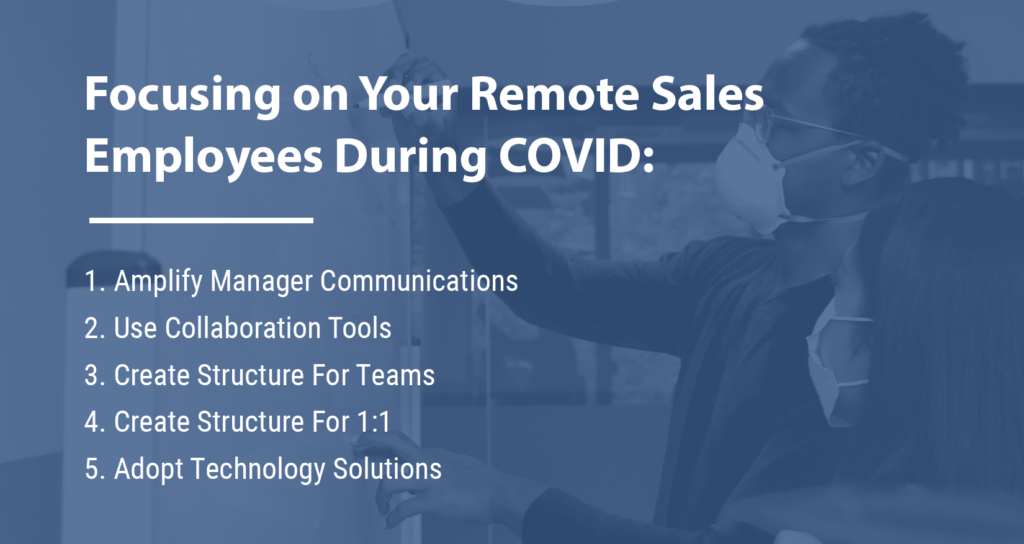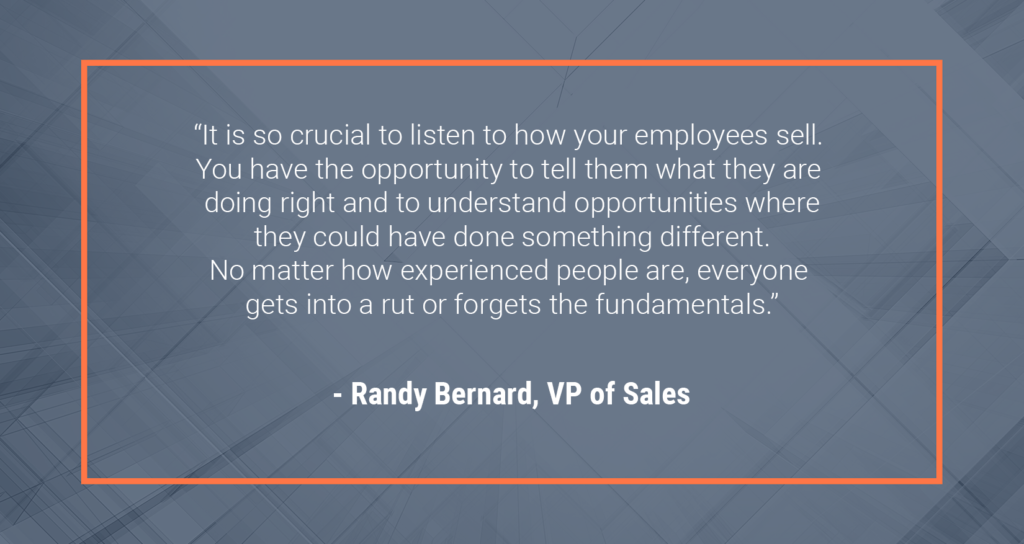
How to Focus on Your Remote Sales Employees During COVID
The massive move of sales organizations across the United States to remote work at the end of first quarter 2020 required B2B sellers to quickly acclimate to virtual selling.
The impact of telecommuting on productivity, company culture, and team dynamics had certainly permeated the business world pre-COVID-19, as worker demand for flexibility, company cost-cutting, and more sophisticated sales technologies supported shifts away from office-based work. In the five years between 2015 and the beginning of 2020, the number of Americans working remotely increased by 1.2 million, or by 20%. Between 2021 and 2025, that number is expected to increase by 87 percent.
In a climate of unimaginable disruption, however, COVID-19 forced the acceleration of a new normal. From our interviews with successful sales leaders, the pandemic created the need, and the opportunity, for changing how B2B sellers operate and sell. So what have top sales professionals prioritized, and how have they become more comfortable and agile, in the shift to remote sales? By pivoting hard to virtual selling, changing their tech stack, adopting new technologies, and being laser focused on both employee management and buyer experiences.

In the first of this two-part series, we focus on ways top sales managers successfully shifted their operations to ensure the success of their reps in the new standard of remote sales. In the second part, we will examine the strategies they used to empower salespeople to locate customers, personalize the customer experience, and turn relationships into revenue.
Amplify Manager Communications
When ZoomInfo (Waltham, MA) moved to remote work in mid-March, “we were already equipped to have people work at home,” said Ned Leutz, senior director of sales. For the subscription-based SaaS company that sells data and information on businesses and employees, the challenge was not technology — remote work readiness was as simple as making sure everyone walked away with their chargers. The challenge instead was how to engage, motivate, and promote productivity for the 100-person team that was dispersed from the Waltham, Massachusetts, sales office and separated from its strong office culture.
Almost immediately, Leutz set up a minimum of three daily meetings, starting with an 8 a.m. call for everyone, including second- and third-line managers.
“Every morning I get in front of the whole organization.” From there, Leutz talks to his reports two more times, at noon and the end of the day, who in turn talk to their reports at least one more time daily, and down the line.
“It might seem like overmanagement, but we have removed the barrier for someone to get a question answered,” Leutz said. “It doesn’t allow anyone to get lost.”
Pre-COVID, account executives could count on that immediate access in the office. During COVID, creating a routine of scheduled calls provided continuity and a system of checks and balances. What at first seemed like overkill has become common practice for a daily check on progress, a look at data and touchpoints, and to verify everyone is on track, Leutz said.
Use Collaboration Tools
At Feefo Inc. (headquartered in London), James Winn, vice president of sales and operations overseeing North and South America, also instituted three daily calls for his Boston-based team. The meetups help everyone to maintain individual connections and provide a platform for collaboration on customer issues, he said. They are platforms for talking outcomes.
“Someone presents a problem, talks about triage, and then there is problem solving,” he said.
Feefo uses Microsoft Teams, a workspace within Microsoft 365/Office 365 that blends chat-based collaboration with document sharing, online meetings, video conferencing, and more.
At ZoomInfo, every team has a channel on the messaging platform Slack, which offers persistent chat rooms organized by topic, private groups, and direct messaging.
“Using Slack has democratized communication,” Leutz said. “In the past, we didn’t have closed doors, but Slack creates immediate access and lowers barriers between team members.” Although ZoomInfo already had the technology, the company “leaned heavily” into its use in 2020, institutionalizing the tool as a critical aspect of day-to-day operations.
Create Structure for Team Connections
Randy Bernard, vice president of sales at Digital.ai Software, Inc. (formerly XebiaLabs), also instituted use of Slack to create team connections in the Boston office when the company went fully remote in March.
In addition to Slack, Bernard addressed the extra challenge of making personal connections by using Zoom video conferencing for onboarding new reps who lost the benefit of the “echo effect,” the valuable experience gained by working in the same space with many other people all doing the same job.
“We had people who had not met another soul in the company, and never experienced the camaraderie, the sports talk, the watercooler chat,” he said. To compensate for that vacuum, Bernard instituted team huddles on Zoom, with no managers allowed.
“When does the remote sales team get to interact without a manager?” he asked. His self-supplied answer: “They don’t.” The company requires team members to gather on Zoom without their manager. “Mom and dad aren’t there. They don’t have to be worried about being judged.”
Create a Structure for One-on-One Connections
Despite the pandemic, growth of ZoomInfo has not wavered. After generating $102 million in sales in the first quarter of 2020, the company went ahead with an initial public offering in June that raised $935 million across 44 million shares. Plus, two more acquisitions were made in October. With a steady stream of new employees, the company had to adopt onboarding and career development processes made for this new virtual world.
One central aspect was the one-on-one connections established through a mentor/buddy system. A new employee was assigned a person to access as a resource, someone to lean on, while going through training. The benefits were mutual: The new hire developed a specific, human connection to the company, and the “buddy” earned the reward of a career-development role.
“The new people who came in said this is the best training they’ve ever had,” Leutz said. “I’m really proud of how we were able to pivot and spin that.”
As another form of fostering individual relationships, walking meetings have become a regular occurrence for Leutz and Winn, who appreciate the opportunity to ditch videoconferencing when they “know conversations are not mission critical.”
“These one-on-one conversations and connections present opportunities to work on employees’ development as a signal to them that we are still invested in them,” Winn said. One-on-one time offers a personal connection to him, and ensures consistent training and skill development, sometimes in as little as 15-minute daily increments.
Leutz uses this same kind of low-tech, high-touch approach to connect daily to his direct reports, often using his cell phone. He talks to them at least an hour a day, but the first few calls are informal — no Slack, no email, just a casual phone call, and then he tries to reach out to half of their direct reports the same way.
“I’ve gotten closer to those who I didn’t know as well,” Leutz said. “I think that bidirectional exposure to leadership needs to stay,” when the company returns to the office. “People should hear from me more than it used to be. If I’m more informed about what is going on in my front-line managers’ world, we’re in the same boat together. It is good for us; it allows us to work in harmony every day.”
It’s one of the lessons these managers have learned about operating during COVID — new ways to approach and value communication.
“It was never my style personally to do forecasts and one-on-ones,” Bernard said. “Now that we are working from home, I think it is so crucial to talk about personal things, goals, what are you doing this weekend, and career aspirations, and maintain those strong personal relations.”

Adapt Technology Solutions
“Sales are harder in this environment,” Bernard said. And they would have been harder without technology. For better onboarding and effective continuous training, sales organizations are adopting more refined use of technology solutions.
Learning Management Systems. With no commute time and fewer stop-and-chats, sales reps have more time for researching prospects and accounting, Bernard said, and they also have more time for learning.
“A lot of companies, when you’re at your desk, you’re selling and dialing constantly,” he said. “Learning was what you did after hours. One of the blessings during COVID is people are finding more time to educate themselves and are learning faster.”
His company implemented the learning management system Allego that provides access to learning materials, follow-up quizzes, and tests to track learning goals.
Sales Engagement Apps. Using an extension of Salesforce, Digital.ai leverages Hoopla for creating competition and challenges, displaying leaderboard progress bars and other displays and alerts to engage and motivate sales team members.
Conversation Coaching. Bernard uses Gong.io to record, transcribe, and analyze sales calls to grade behaviors, questions, and how sales rep overturn objections.
“It is so crucial to listen to your people sell,” Bernard said. “To tell them what they are doing right and to understand opportunities where they could have done something different. No matter how experienced people are, everyone gets into a rut or forgets the fundamentals.”
Rate the Trainer. While Net Promoter Score is typically used to measure customer experiences, Digital.ai uses it differently — for sales reps to provide feedback about their learning and to rate their sales training.
Operate Less from the Gut
“The biggest questions in working with employees remotely is how can you measure them effectively; how can you continue to develop them; and how can you keep them connected with the group?” Winn said.
All of those questions led these sales managers to operate less “from the gut” and more from a requirement of data collection, analysis, and written communications.
Digital.ai invested more in its Salesforce dashboard to gather intel on key performance indicators. Feefo established a deeper data-centric evaluation of performance, including time spent on the phone, number of dials and emails, email open rates, who is being called, etc.
“All employees understand the standard for performance and how they are going to be measured. The metrics are scoreboarded, and everyone can see where they are in the stack. It was important for me to have that data so I can articulate what the challenge looks like for my CEO” — the activities completed, the adjustments needed to be made, and the focus for marketing dollars spend in response.
At ZoomInfo, in the past there was some ambiguity in general accomplishments — “You hit your number or you didn’t; you closed the deals or you didn’t,” Leutz said — during pandemic times, goals have been created for those factors that could be controlled, like non-revenue activities.
“Meetings, calls, all the things in your control that show you are getting something done in a day, and are not related to closing,” Leutz said. The goals were created, but not the means. That is, “We made clear of what was required, and allowed people room in how to get ‘there,’” Leutz said. Operating in a pandemic-hampered economy, everyone could juggle their tasks on their own time, as long as they achieved them. With that balance, “we are still on a trajectory of growth. We’ve done well during this time,” Leutz said.
As precise as it got in measuring productivity, ZoomInfo also zeroed in on the written communications it provided the sales team. With the addition of new hires for sales enablement, it rapidly expanded the written communications to include information on best practices for managing remote work and creating engaging video interactions in addition to standard content about product set (positioning, sales best practices, driving conversations).
“When you are in the office you can constantly communicate on the floor, have lunch, listen live, and debrief,” Leutz said. “All of that tribal knowledge was shared in an open and friendly setting.” His question as the pandemic continued was “How do I add 50 people to the organization without losing productivity and put them in a position to not fail? A lot of it came down to communication. We haven’t added any degradation when adding new folks. Instead, our time to ramp up came down, which is not what we expected.”
Embrace Empathy for Employees
In opening their homes and their lives to each other, managers have experienced more of the humanness of their employees, and vice versa. While sales performance has always been about driving results, the new social and economic climate puts new demands and challenges on our daily lives, giving rise to the need for deeper understanding, empathy, and trust.
“People have had to address things they haven’t before,” Leutz said. Like employees not having childcare, schools closing, inability to work certain hours. “These are things that happened early on, and are still happening, that we didn’t have to address before. We’re dealing with a whole set of challenges, and trying to have extreme understanding and empathy while trying to drive a results-oriented business,” he said. “The only thing is to be as open and honest with folks and hope they are open and honest back.”
To Stay With Remote Sales or Not?
In a Gartner survey of CFOs, 74 percent said they planned to permanently shift to more remote work once COVID-19 dangers have passed, but in varying degrees. More than 50 percent said they would move only 2 percent of their workforce to remote work, while nearly a fifth said at least 20 percent would remain remote.
In the future, some companies are looking to realize the cost benefits of a remote workforce. Although remote selling has a place, none of these executives advocate life without the in-person connection, even if over the long-term office footprints were to become smaller.
“I think that for companies on growth trajectories, doing a lot of hiring, it is important to be back in the office,” Winn said. “Onboarding 10 or more people, it’s easier to do that in an office setting.”
“I believe that sales people that are earlier in their careers absolutely are far better off in an office environment, for camaraderie, teamwork, learning what is inherent to sales, being coached, and getting into the workforce and learning those foundational strengths,” Bernard said. As well, Bernard points out that early in a sales career, the rejections are greater than the successes, and even the hardiest of humans can crumble from the negativity in isolation. At that point, it’s better to be a part of team.
“But I believe corporations can save billions of dollars by allowing their more senior sales people, who don’t need that day-to-day structure and are actually self-aware and self-sufficient, to work remotely and from home,” Bernard said. “It has nothing to do with age; it has to do with tenure in the field. The more junior you are, they should be getting back into the office. A little bit more experienced, this new norm of remote can be massively beneficial and a perk.”
“There’s no data that I can point at that says there would be a problem” with wholly remote sales, Leutz said. “All the data says things would be fine; things could even get better.” But without a human connection, sales would suffer. “At some point, we will lose something.”
Contact Us for Sales Recruiting
At DANA Associates, we have found that successful remote workers typically have highly developed skills. While we all hope to be back in the office soon, our proven sales recruiting practice enables us to find strategic hires who thrive at our client companies. If you need experienced professionals to fill upper-level sales positions, DANA can help.
Contact us today to discover the DANA difference for yourself and to see why we are the top remote sales talent recruiting agency in the Boston area.

